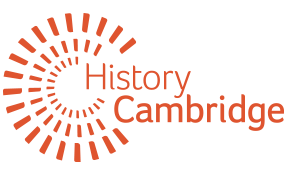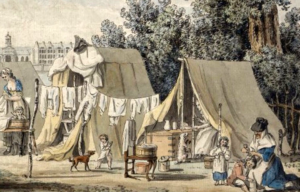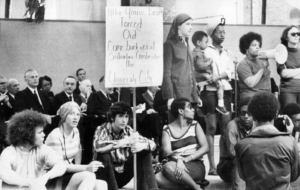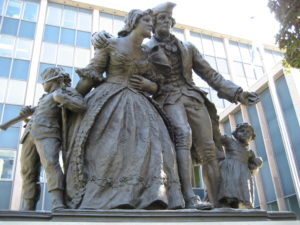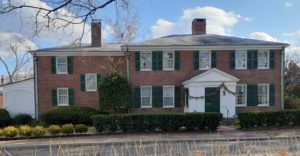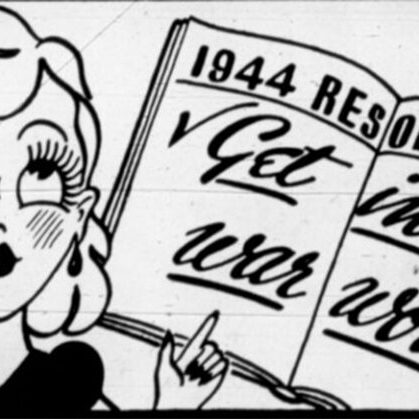
New Years in Cambridge of the past held meaning as ways to address moments of crisis such as war
By Beth Folsom, 2024
For most of us in present-day Cambridge, the arrival of a new year brings with it both reflection on the past year and the promise of a new start; whether we want to eat healthier, get organized, start exercising or any other of the many resolutions we make each New Year’s, the moment makes all goals seem possible. The same was true for Cantabrigians of the past who, like us, viewed the turning of the calendar page as rife with potential for self-improvement and collective action.
Although New Year’s Day is now generally set aside for rest, renewal and, often, recovery from the previous night’s celebrations, Americans in previous centuries considered it an important part of the Christmas season. In the wake of the Protestant Reformation of 16th century Europe, when celebrations of Christmas were forbidden as sacrilegious, New Year’s Day became the day on which presents were exchanged and the promise of new life and light in the darkness of winter was heralded with food, music and revelry. The Puritan colonists who arrived in New England nearly four centuries ago brought these traditions with them and, even as Christmas reentered the celebratory landscape, New Year’s Eve and New Year’s Day retained their status as a time of gift-giving and meal-sharinag for many in Cambridge and beyond.
By the mid-19th century, when news could be transmitted by railroad and telegraph, the new year’s start became a time for collective reflection on the past year and hopes for the year to come. This was particularly true at times of national or international crisis, most notably during America’s Civil War. Although the armed conflict did not start until April 1861, sectional tensions had long been simmering between states in the North, South and West over the issue of slavery and its implications for the future of the young nation. New Year’s Day had long been seen as a chance to offer oneself and others a “clean slate,” and many expressed the hope that Americans could use this opportunity to extend an olive branch to counterparts in other areas of the country.
A January 1858 article in the Cambridge Chronicle described a French Canadian tradition, brought to Cambridge by those emigrating to the city: “If any feud or quarrel has occurred during the year between members of a family, or between neighbors and acquaintances, on this day either party has but to make the New Year’s call – no explanations are made, nothing said upon the topic of grievance – and all is wiped away, and peace and goodwill restored.” The author opines that the broader Cambridge community, as well as the nation at large, would be well served to adopt this tradition, particularly at such a divisive time.
Americans were not able to bridge the sectional gaps between them, however, and the nation was plunged into civil war. At the close of 1861, the Chronicle warned that “New Years will certainly succeed Christmas, unless Secession should, ere its arrival, snuff out our national candle, and then we shall all grope our way in the dark and be governed by King Cotton.” In Cambridge, as in most of the North, the fear that the Southern states would break away and form their own country – or that the entire United States would come under the thumb of the slaveholding powers – was very real, and the start of a new year was a time to recognize that fear and vow to take action.
The most crucial New Year’s event of the Civil War occurred Jan. 1, 1863, when the Emancipation Proclamation took effect. The previous September, President Abraham Lincoln had issued an executive order that those who were enslaved in states in rebellion against the Union would be declared free on New Year’s Day. Now heralded as perhaps Lincoln’s greatest accomplishment, the Emancipation Proclamation was as much a political, economic and psychological weapon against the Confederacy as it was a gesture of humanitarianism or justice. The Proclamation did not apply to those enslaved in the so-called “border states” that remained loyal to the Union (Delaware, Maryland, Kentucky, Missouri and, later, West Virginia), and was designed as a punishment for secessionist states rather than a blanket condemnation of the slave system. But these shortcomings were largely overlooked by those in Cambridge and much of the North, and the Proclamation’s enactment on New Year’s Day was viewed as a symbol of change and possibility for the end of the war and the restoration of peace.
It would take several more years, but by New Year’s Day of 1866 the nation was reunited, at least in theory. In its annual assessment of the previous year, the Chronicle of Dec. 30, 1865, stated of chattel slavery that, “the Nation relieved of that incubus, now stands erect, prepared to urge on those other measures of Political and Social improvement, which will eventuate in the elevation of humanity to higher planes of thought and action, than were dreamed of by the author of Utopia.” Not content to have the reunited nation rest on its laurels, Cantabrigians challenged each other and their compatriots in other parts of the country to turn their attention to the ills that still remained in society in the year ahead.
In the 20th century, two more wars would again prompt Cambridge to take stock of the local, national and international conditions on the eve of a new year. Although what would come to be known as World War I began in 1914, the United States did not enter the war until 1917. The armistice that ended the war took effect in November 1918, making America’s direct involvement short-lived, but the psychological effects of the war – from its international nature to its introduction of new forms of warfare and weaponry – were strongly felt across the country.
One way in which Cantabrigians took action during this period was to raise funds for soldiers and their families, and no effort was more successful than the annual Cambridge Elks New Year’s Eve gala. The Elks had long had a tradition of gathering for a grand party on that night, but during World War I the focus of the event shifted to honoring those who were fighting and providing emotional and financial support for the families they had left behind. Organizers of the 1917 ball decided to curtail some of the more extravagant elements of previous celebrations, including a fireworks display, to dedicate more funds to soldiers. Their efforts raised more than $1,500 (equivalent to almost $37,000 today). Not to be outdone, the Cambridge chapter of the Daughters of Massachusetts held its annual New Year’s Tea that same week, adopting a “patriotic” theme and highlighting that their members had “sent more than 100 articles to the War Relief Fund, including knitted sweaters, mufflers, socks, helmets, three-yard bandages, eye bandages, hospital afghans, mittens, face cloths, comfort pillows and sponge mitts,” with a pledge to send even more in the coming year.
Even though the war was over by New Year’s Day of 1919, the debt incurred would remain an issue of concern for those in Cambridge, as it was throughout the nation. One way Americans could aid in the reduction of that debt was through the purchase of war savings stamps, and many companies chose this method of investment to thank their employees at the New Year while simultaneously supporting the government. On New Year’s Eve of 1918, according to the Chronicle, “over two hundred employees of the Boston Woven Hose & Rubber Co. … gathered to receive an expression of appreciation in the form of War Savings stamps … For several years the company has taken this method of recognizing those employees who have continued with the company over a long term of years, and whose continuous efforts contributed so much to the welfare of this well-known and prosperous enterprise. Over 300 War Savings stamps were distributed.”
World War I was termed “the war to end all wars,” but just two decades after its end, Europe was plunged back into turmoil. When the United States entered the war in December 1941, after the bombing of Pearl Harbor by the Japanese, Cambridge once again became part of the homefront and Cantabrigians did their part to contribute to the war effort. And, once again, New Year’s became a time to think ahead to the coming year and to recommit to supporting the troops. The Chronicle’s “New Year’s Thought” on Dec. 31, 1942, was that “total war means that everything we do or say this year will either help to win or lose the war” – a heavy charge indeed to the paper’s readership!
Cambridge residents were encouraged to make New Year’s resolutions to buy war stamps and bonds and to contribute to the war effort in other ways, including donating blood to the Red Cross. Women in particular were targeted by articles and advertisements for everything from active service in the Women’s Army Corps to paid work in local factories. One suggested New Year’s resolution for Cambridge women in 1945 was to “release a nurse to care for sick and wounded servicemen” by either learning home nursing themselves or helping to care for the children of trained nurses so that they could enlist for active duty.
When at last World War II was over, the Cambridge Sentinel sent New Year’s wishes to its readers on the cusp of 1946:
“As you approach the beginning of the new year, it is well to be companioned and sustained by hope. Tennyson might have been writing of our first postwar Christmas when he said:
Hope the best, but hold the present, fatal daughter of the past,
Shape your heart to front the hour, but dream not that the hour will last.
The war is over and we can only hope and pray it was the last.”
After three major wars in less than a century, Cantabrigians – like all Americans – were optimistic about the future as 1946 dawned, but they would not forget the lessons of wartime New Year’s past, lest they be called upon again to mark the new year with such resolutions once again.
This article originally appeared in Cambridge Day.
